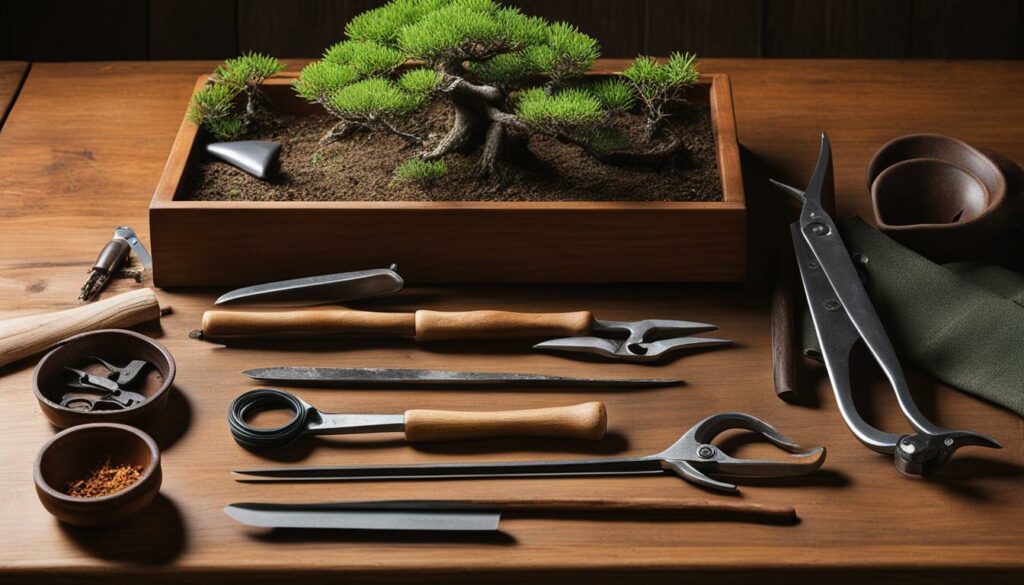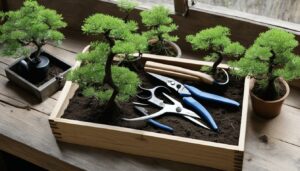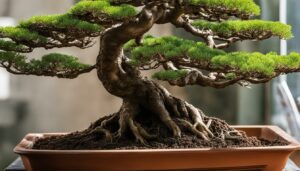Embarking on the delicate journey of bonsai cultivation requires not only patience and creativity but also the right set of tools. Your Bonsai tool kit holds the essence of bringing miniature landscapes to life, and understanding its components—the pruning tools, maintenance equipment, and the significance of tool care—is fundamental to the practice. Whether you are nurturing your first bonsai or are a seasoned artist, this comprehensive guide will walk you through the must-have bonsai essentials designed to finesse this ancient art form.
Every stroke, cut, and adjustment requires precision—a reflection of both your vision and the quality of your tools. The finesse in the trimming, the art of shaping, and the overall health of your bonsai are all influenced by the maintenance equipment you employ. Regular tool care ensures your equipment performs optimally, prolonging the life of both your toolkit and your bonsai. Let’s delve into the world of bonsai tools and uncover the key instruments that will make your bonsai flourish exquisitely.
Key Takeaways
- Discover the essential items that every bonsai artist needs in their toolkit.
- Learn the importance of high-quality pruning tools in sculpting your bonsai.
- Understand why ongoing maintenance equipment is vital for the health of your bonsai tree.
- Receive practical tips for tool care to extend the life and effectiveness of your bonsai tools.
- Explore how integrating the correct tools into your practice elevates the art of bonsai to new heights.
Understanding the Importance of Bonsai Tools
The cultivation of bonsai trees is an art that requires more than just a green thumb; it demands a set of specialized Bonsai Tools. Each tool in your bonsai repertoire serves a unique purpose, contributing to the detailed and delicate nature of bonsai care. From pruning branches to fine-tuning the roots, tool care and the use of appropriate maintenance equipment play pivotal roles in the health and aesthetics of these miniature trees.
Investing in quality tools is not merely a luxury but a necessity for bonsai enthusiasts. Proper tools ensure that you can execute precise cuts without damaging the plant, thereby maintaining its miniature form while encouraging healthy growth. Many new hobbyists overlook the importance of tool care, which leads to premature wear and tear. Consistent maintenance of your equipment not only prolongs its life but also protects your bonsai from infections potentially spread by dirty tools.
High-quality bonsai tools are designed to endure the rigorous demands of intricate care without compromising the tree’s delicate structures.
- Pruning shears must provide clean cuts to prevent bark tearing.
- Wire cutters are essential for shaping without scarring the branches.
- Root rakes and hooks assist in repotting without root damage.
- Knob cutters help in creating smooth wounds that heal efficiently.
| Tool Type | Function | Importance |
|---|---|---|
| Pruning Shears | Cutting leaves and small branches | Essential for maintaining the tree’s shape and health |
| Concave Cutters | Removing branches | Creates wounds that heal with minimal scarring |
| Wire Cutters | Trimming bonsai wire | Crucial for styling the tree without injury |
| Root Rake | Loosening soil and untangling roots | Vital for healthy repotting procedures |
Maintaining these tools is indispensable, as rust and damage can become an adversary in the quest for bonsai perfection. Use designated maintenance equipment to clean and oil your tools after each session, ensuring longevity and precision in every cut.
The Basic Bonsai Tool Kit
Embarking on the bonsai’s journey begins with assembling your basic bonsai tool kit, the cornerstone of bonsai care. High-quality pruning tools, containers, and soil mixes are not just mere accessories; they are pivotal in cultivating the exquisite miniature landscapes of bonsai that enthusiasts adore. With careful attention to these critical elements, your bonsai will thrive, showcasing the harmony between nature and nurtured artistry.
Selecting the Right Container for Your Bonsai
Choosing a container for your bonsai transcends aesthetics and delves into the functional health of your miniature tree. The container sets the stage for your bonsai’s future, affecting not only how it grows but also how it is perceived. Opt for a container that complements your bonsai’s style and size; this ensures the roots have adequate space to grow without compromising the tree’s overall balance.
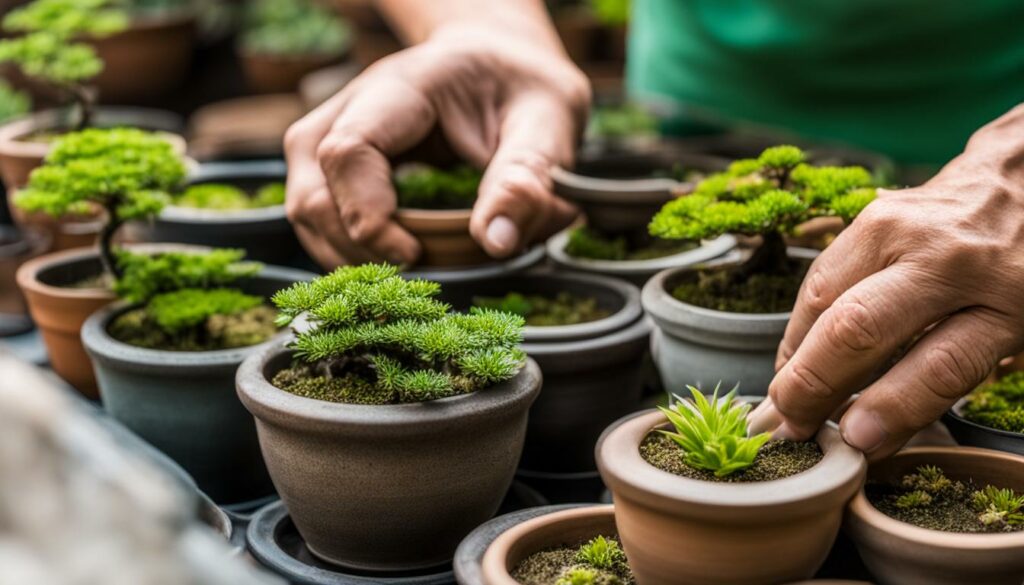
Sourcing Quality Soil Mixes for Optimal Growth
Sourcing high-grade soil mixes is akin to providing a nutritious diet for your bonsai, allowing it to reach its full potential. The correct mixture of soil influences water retention, aeration, and nutrient availability, all of which are critical for healthy bonsai growth. Invest time in understanding and selecting soil mixes to create the perfect growing environment for your plant.
| Soil Attribute | Suitable for Bonsai | Unsuitable for Bonsai |
|---|---|---|
| Drainage | Fast draining to prevent root rot | Slow draining which may lead to waterlogging |
| Particle Size | Small to medium, allowing for tight root growth | Large, leading to loose root structure |
| Nutrient Content | Well-balanced with slow-releasing fertilizers | Low in nutrients or excessive fertilization |
| pH Level | Slightly acidic to neutral | Highly acidic or basic |
Advanced Pruning Tools: Shaping Your Bonsai’s Future
The art of bonsai shaping transcends basic gardening—requiring precision, patience, and the right pruning tools to sculpt living masterpieces. Handpicked from an array of Bonsai tool kits, advanced pruning tools empower you to define and refine your bonsai’s silhouette. Below, we detail those specialized implements that cater to your bonsai’s unique aesthetic ambitions.
As you delve into refining your bonsai, it is imperative to choose tools that align with the specific growth patterns and style you envision. From delicate topiary artistry to bold structural shapings, these advanced tools facilitate meticulous cuts and provide the control needed for masterful refinement:
- Concave Branch Cutters: Ideal for removing branches cleanly, leaving a wound that heals with minimal scarring.
- Knob Cutters: Used to extract undesirable knobs and swellings, ensuring a smooth and natural appearance of the trunk and branches.
- Spherical Knob Cutters: These are perfect for deeper, more precise cutting, helping to craft a more polished look.
- Wire Cutters: Essential for safely removing wires that shape and train branches, preventing any damage to the bark.
- Bud Scissors: With fine tips, these scissors are used for delicate trimming and pinching of buds.
In the spirit of further clarifying the functions of these indispensable tools, the comparative table below provides insights into when and why each tool is apt for certain tasks:
| Tool Type | Primary Use | Best For |
|---|---|---|
| Concave Branch Cutters | Creating concave cuts for quick healing | General pruning and branch removal |
| Knob Cutters | Removing unsightly knobs and bulges | Improving trunk aesthetics |
| Spherical Knob Cutters | Making hollow cuts into wood | Advanced sculpting and detail work |
| Wire Cutters | Cutting and removing training wires | Shaping and training without damaging the bark |
| Bud Scissors | Precise trimming of buds and small branches | Refining and maintaining small bonsai |
To realize the full potential of these tools and achieve the desired effect, always remember to apply them with care and attentiveness. With each snip and adjustment, you shape not only your bonsai’s present appearance but also its future development.
Exploring Specialty Bonsai Tools
When you delve deeper into the world of bonsai, you encounter specialized tasks demanding equally specialized tools. Crafting a bonsai is not just about growing a tree; it is an art form that requires precision and a delicate touch. In this section, we explore the specific tools that contribute to the intricate detailing and precise shaping of your bonsai masterpiece.
Detailing Knives and Carving Tools
Detailing knives and carving tools are essential for sculpting and detailing the fine aspects of your bonsai. These tools allow for meticulous work, like creating smooth curvatures on trunks or hollowing out areas for a more mature appearance. With the help of these carefully designed Specialty Bonsai Tools, you can add character and depth that transform your bonsai into a true reflection of nature’s beauty.
Detailing knives are shaped to provide superior control and precision, facilitating the creation of delicate features and ensuring your cuts are clean and precise. Meanwhile, the broader selection of carving tools enable the removal of larger pieces of wood without damaging the surrounding areas, crucial for styling and aesthetic corrections.
Bonsai Branch Benders and Jacks
Giving your bonsai the ideal shape often requires more than just pruning. Bonsai Branch Benders and jacks are indispensable tools designed to adjust and reposition branches gradually over time without causing stress or damage. The controlled tension they apply helps achieve the desired angles and curves, allowing you to sculpt the tree’s silhouette to perfection.
Branch benders, with their adjustable arms and grip, provide the nuanced pressure needed for precise bending. Coupled with jacks, which can handle thicker branches, these tools empower you to guide your bonsai’s growth with an artist’s touch. Through their application, even the most resistant branches can be trained to grow in the direction that best suits your bonsai’s design.
In summary, adding Specialty Bonsai Tools such as detailing knives, carving tools, and bonsai branch benders to your repertoire elevates the potential of your bonsai. Utilizing these specialized instruments, you are equipped to meticulously shape and detail your bonsai, bringing your artistic vision to life with each deliberate cut and bend.
Maintaining the Health of Your Bonsai
Meticulous care is essential to foster the growth of your bonsai and ensure its health is never compromised. One of the most crucial aspects of bonsai care involves the soil and watering disciplines you adopt. With specialized tools like soil sieves and innovative watering equipment, you can precision-tune the care routine your bonsai requires.
Soil Sieves and Scoops for Repotting Needs
When it’s time to repot your bonsai, ensuring the soil is free of debris and adequately aerated is vital for root health. That’s where soil sieves come into play. With varying mesh sizes, they enable you to sift and refine your soil to the ideal texture. For measuring and transferring soil, scoops are indispensable. They allow for precision while minimizing waste and mess during the repotting process.
| Tool Type | Function | Benefit |
|---|---|---|
| Fine Mesh Soil Sieve | Separating fine soil particles | Improves soil aeration and drainage |
| Coarse Mesh Soil Sieve | Filtering out large debris | Prevents root damage and pest infestation |
| Soil Scoop Set | Transferring and measuring soil | Ensures accuracy and cleanliness |
Watering Equipment for Proper Hydration
Bonsais require a delicate balance of moisture, making specialized watering equipment a necessity. From fine mist sprayers that tenderly hydrate your bonsai’s foliage to watering cans with long spouts for controlled soil watering, choosing the right tool can mean the difference between thriving and merely surviving.
- Precision Watering Cans: With slender spouts for exact water delivery to the soil-base without disturbing the layout.
- Mist Sprayers: Perfect for hydrating leaves and providing humidity, misters support bonsai health without oversaturation.
- Automatic Drip Irrigation Systems: For the enthusiast looking for consistency and automated care, these systems manage watering even when you’re away.
Considering these tools, you can keep your bonsai in peak condition, ensuring a harmonious blend of form and well-being. Remember, the right soil sieves aid in creating an optimal environment for root growth, while appropriate watering equipment secures the hydration your bonsai needs for its health and aesthetic charm.
Choosing Bonsai Tools That Last
When you invest in a Bonsai tool kit, looking for longevity in each tool is paramount. The right maintenance equipment can be a significant investment upfront, but quality tools withstand the test of time, making them more cost-effective in the long run. To help you make informed decisions, here are some key tips on selecting tools that ensure durability and effective tool care.
Detecting Quality: Quality materials are the essence of long-lasting tools. Stainless steel is a superior choice, known for its resistance to corrosion and ease of cleaning. Pay close attention to the craftsmanship; joints and hinges should feel firm and smooth, which indicates that the tools will function well over time.
Brand Reputation: Established brands in the bonsai community often carry a legacy of quality. Researching and choosing brands reputed for their bonsai tools can save you from the pitfalls of lower quality alternatives.
- Consider user reviews and testimonials as they reflect real-life usage and durability.
- Look for guarantees or warranties, which can be a sign of a manufacturer’s confidence in their product.
Tool Care: Even the best tools require proper care. Ensuring your maintenance equipment is clean, sharpened, and stored correctly will extend their lifespan dramatically.
Below is a quick guide to understanding the aspects of quality that you should expect from various types of bonsai tools:
| Tool Type | Expected Quality Feature | Maintenance Tip |
|---|---|---|
| Pruning Shears | High-grade carbon steel, ergonomic handles | Oil joints regularly, keep blades sharp |
| Wire Cutters | Flush cutting edges, comfort grip | Clean after every use, dry completely |
| Concave Cutters | Smooth action, durable blade edge | Avoid cutting wires, clean resin build-up |
| Rakes and Spatulas | Stainless steel construction, solid handle | Rinse soil off, disinfect to prevent disease spread |
To embody the ethos of bonsai and its meticulous nature, adopting tools that echo this sentiment is essential. By selecting the right Bonsai tool kit from the start and committing to diligent tool care, your practice will not only flourish but also become a more enjoyable and fulfilling endeavor.
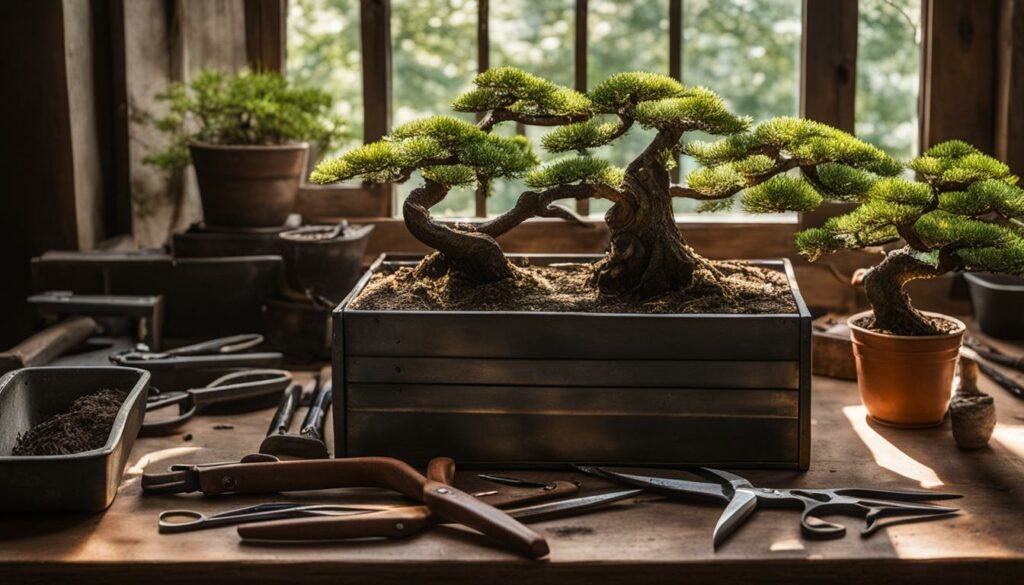
Ensuring Longevity: Bonsai Tool Care
Investing in the art of bonsai cultivation comes with the responsibility of maintaining your equipment. Proper tool care is not only a matter of preservation but also a testament to your dedication to the craft. Ensuring your maintenance equipment is clean and well-cared for will keep your tools functioning at their best and your bonsai looking its finest.
Cleaning Bonsai Tools After Each Use
Every expert knows that Cleaning Bonsai Tools after each use is crucial. Residual sap and plant material can dull blades and invite rust or disease. Following these steps will extend the lifespan of your tools:
- Wipe down blades with a clean cloth after each cut.
- Use soapy water for a deep clean, ensuring to reach into crevices with a soft-bristled brush.
- Rinse with clear water and dry thoroughly to avoid corrosion.
- Apply a thin coat of oil to your tools to condition and protect the metal.
Storing Your Tools Correctly to Prevent Rust
The right storage solutions are key to preventing rust and keeping your tools in pristine condition. Here are recommendations to maintain your equipment:
| Storage Method | Benefits | Considerations |
|---|---|---|
| Tool Roll | Compact and portable, keeps individual tools secure | Ensure material is breathable and tools are dry before rolling |
| Wall-mounted magnetic strip | Convenient access and display, saves space | Choose a rust-resistant material and install in a dry area |
| Toolbox with silica gel packs | Protects from dust, adds a layer of moisture control | Regularly check and replace silica packs to maintain efficacy |
The Artistry of Wiring: Tools for Shaping Bonsai
Wiring is an artistic tradition in the bonsai world that requires an understanding of both the emotional and physiological responses of trees. It’s about guiding growth without compromising the tree’s health, which is why every enthusiast needs the right wiring tools for bonsai shaping. Let’s discuss how to choose these tools and utilize them effectively for your bonsai.
Selecting the Suitable Wire for Your Bonsai Tree
When you’re selecting wire, you must consider both the size and species of your bonsai. Different trees have varying levels of flexibility and resilience, which means that the wire you choose must be strong enough to hold the branches in place without damaging the delicate bark. Aluminum and copper are the most common types of wiring materials used due to their flexibility and strength.
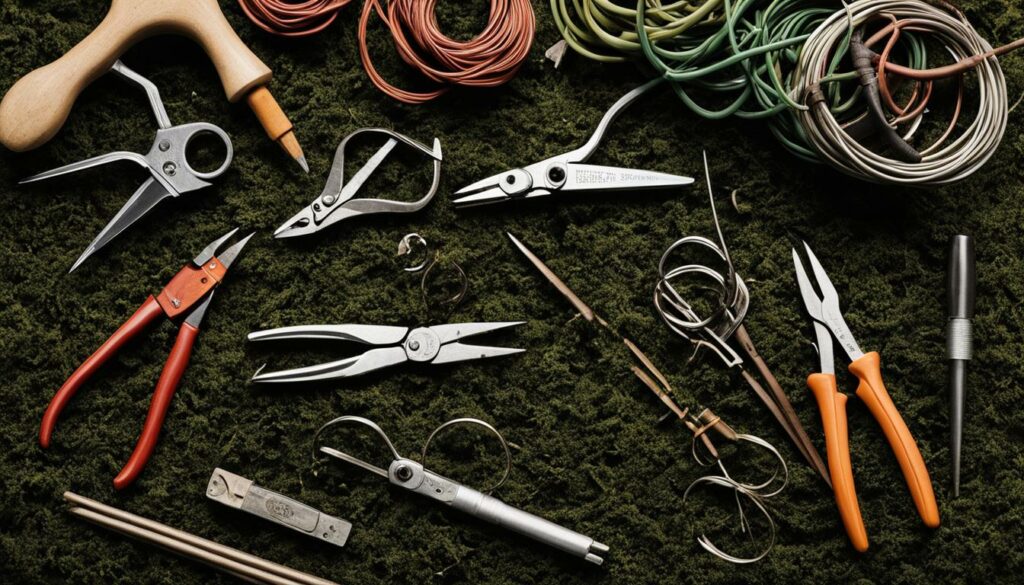
| Wire Type | Characteristics | Suitable for Tree Type |
|---|---|---|
| Aluminum Wire | Lightweight, flexible, easier to bend | Deciduous and young bonsais |
| Copper Wire | More strength, holds shape longer | Conifers and older bonsais |
Using Pliers and Wire Cutters for Precision Work
Now that you’ve chosen the right wire, it’s essential to have precision tools like pliers and wire cutters on hand. Pliers can help you manipulate the wire around branches safely, while wire cutters are indispensable for trimming off excess wire without injuring the tree. High-quality wiring tools enable accurate control for intricate bonsai shaping, and ensure that each bend and twist contributes to your desired aesthetic.
- Concave Cutters: Create hollow wounds to facilitate better healing
- Jin Pliers: Strip away bark and wood for creating jin or shari effects
- Spherical Knob Cutters: Chop heavier branches and knobs with minimal scarring
A well-executed wiring is invisible in the final presentation of bonsai, yet it’s the backbone of the tree’s design. With these wiring tools in your repertoire, you’re well-equipped to shape your bonsai with artistry and precision.
Mastering the Use of Bonsai Tools for Optimal Results
Achieving mastery with your Bonsai tool kit is a journey that unfolds in the grace of each clip and the delicacy of each trim. Understanding the precision required by pruning tools and the necessity for reliable maintenance equipment can elevate your bonsai artistry to new heights. Let’s delve into the techniques that can help you yield the most desirable outcomes.
Each bonsai tree is unique, and as such, it requires a nuanced approach. A properly maintained bonsai is the result of meticulous care and the correct use of tools, including:
- Shears for precise cuts
- Wire cutters for shaping branches
- Root rakes for soil aeration
- Tweezers for debris removal
To truly master these tools, consider the following table, which offers insights into the function of key items within your arsenal:
| Tool | Use | Care Instructions |
|---|---|---|
| Concave Branch Cutter | Creates smooth cuts that heal rapidly | Clean after use, oil hinges regularly |
| Spherical Knob Cutter | Removes excess wood from concave cuts | Store dry, sharpen blades as needed |
| Bud Scissors | Fine trimming without damaging nearby growth | Wipe down blades, keep free from sap build-up |
| Wire Pliers | Assists in wiring branches securely | Check for wear, replace if grip lessens |
As you continue to gain experience, you’ll develop a sense for when and how to use each tool to bring out the best in your bonsai tree. Remember to perform regular maintenance on your maintenance equipment to ensure that they are always ready when needed. With time, your hands will move intuitively, shaping your bonsai with an almost innate knowledge of the life within its branches.
Remember, the beauty of bonsai lies in the details. Be patient, practice, and always refine your technique to achieve optimal results.
Embrace the process of learning and enjoy the tranquil satisfaction that comes with the methodical care of your bonsai. Your dedication to mastering these tools will be evident in every lush leaf and perfectly poised branch of your miniature trees.
Avoiding Common Pitfalls in Bonsai Tool Usage
When cultivating the delicate art of bonsai, it’s crucial to be aware of the common pitfalls that can impact the health and appearance of your miniature trees. A deep understanding of how to effectively use pruning tools and the importance of diligent tool care will help you avoid such bonsai errors and ensure the prosperity of your bonsai.
Over-pruning and Other Common Bonsai Errors
Over-pruning is a typical mistake that can severely damage your bonsai. Apart from unnecessary stress on the plant, it can lead to stunted growth or even death. To cultivate a thriving bonsai, remember that less is often more. Pruning should be done strategically and sparingly, focusing on shaping rather than drastic size reduction.
- Avoid cutting off more than one-third of the foliage during a single pruning session.
- Never remove all the leaves from a healthy bonsai; this may cause irreparable harm.
- Pay careful attention to the recovery of your bonsai after each pruning session before proceeding further.
- Practice caution when shaping roots during repotting to maintain the plant’s vitality.
Understanding the Detrimental Effects of Neglecting Tool Care
Another common bonsai error is neglecting the care of your tools, which can lead to poor plant health and unsightly results. Keeping pruning tools sharp and clean ensures precise cuts that heal quickly, preventing disease and other complications. Here’s a straightforward table illustrating the do’s and don’ts of bonsai tool care:
| Tool Care Do’s | Tool Care Don’ts |
|---|---|
| Clean tools after every use to remove sap and debris. | Leave tools dirty, as this can spread disease. |
| Sharpen cutting edges regularly for clean cuts. | Use dull tools that damage branches and delay healing. |
| Oil moving parts to prevent rust and ensure smooth operation. | Store tools in humid or wet conditions, promoting rust. |
| Keep tools dry and store them in a clean, protected environment. | Ignore signs of wear and tear that could compromise your bonsai’s health. |
Consistent care for your bonsai tools not only benefits your plants but also extends the life of your investment, facilitating the artful practice of bonsai gardening for years to come.
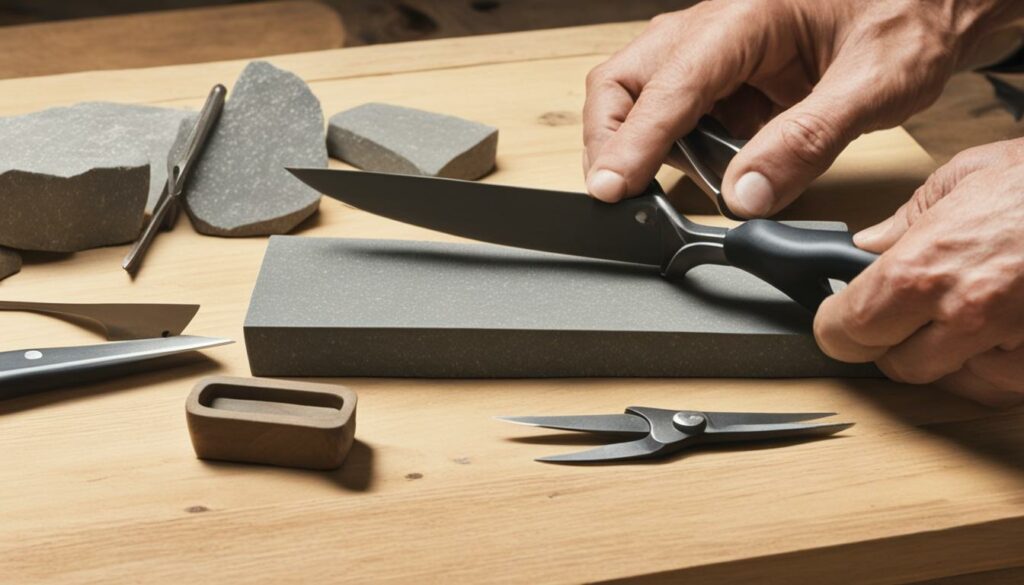
Bonsai Tools: Worth the Investment
Embarking on the journey of bonsai cultivation requires not just patience and creativity but also the right bonsai tool kit. Investing in high-quality maintenance equipment is not only about having the right tools at hand but understanding their role in elevating your bonsai practice to a professional level. High-caliber tools lead to more precise work, less stress on the plants, and ultimately, a more beautiful bonsai.
Consider the longevity and effectiveness a well-crafted tool brings to the table. Cheaper tools might save you money upfront but can result in higher costs over time due to the need for replacements or the potential damage to your delicate trees. With that in mind, let’s evaluate the difference a quality bonsai tool kit can make:
| Tool Quality | Features | Benefits | Expected Lifespan |
|---|---|---|---|
| Premium Quality | Ergonomic, Japanese steel, Precision cutting | Less strain on hands, Clean cuts for better tree health, Long-term cost efficiency | Many years with proper care |
| Standard Quality | Basic functionality, Mixed materials | Functional for beginners, Accessible price point | 1-3 years depending on care and use |
| Low Quality | Dull blades, Poor ergonomic design | Frequent tool replacement costs, Potential harm to bonsai | Less than a year |
Your bonsai is a living work of art and every cut, bend, or shaping technique you apply has the power to change its future. When you invest in a professional-grade bonsai tool kit, you invest in the health and beauty of your bonsai. These tools, designed for specific tasks in bonsai maintenance, ensure you are equipped to handle delicate procedures with precision and care.
Remember, quality tools do not only serve you better in daily maintenance but also become integral companions in this ancient art form. With the proper maintenance equipment, your focus can shift from the worry of tools’ performance to the true enjoyment and satisfaction found in bonsai care.
In summary, top-notch bonsai tools are not an expense but an investment—one that contributes directly to your bonsai’s growth and your growth as a bonsai artist. Devote to tools that serve both your passion and your bonsai, leading you to achieve tranquil and living masterpieces.
Appreciating the Artistic Value of Bonsai Tools
The intricate world of bonsai is not just about careful cultivation; it’s also a testament to the aesthetic grace that the right bonsai tool kit can bring into play. Like a painter’s brush or a sculptor’s chisel, bonsai tools are an extension of the artist’s hand, where precision blends with creativity to foster living art. It’s in this blend that the true artistic value of quality tools is found. They are not merely instruments; they become part of the creative process itself.
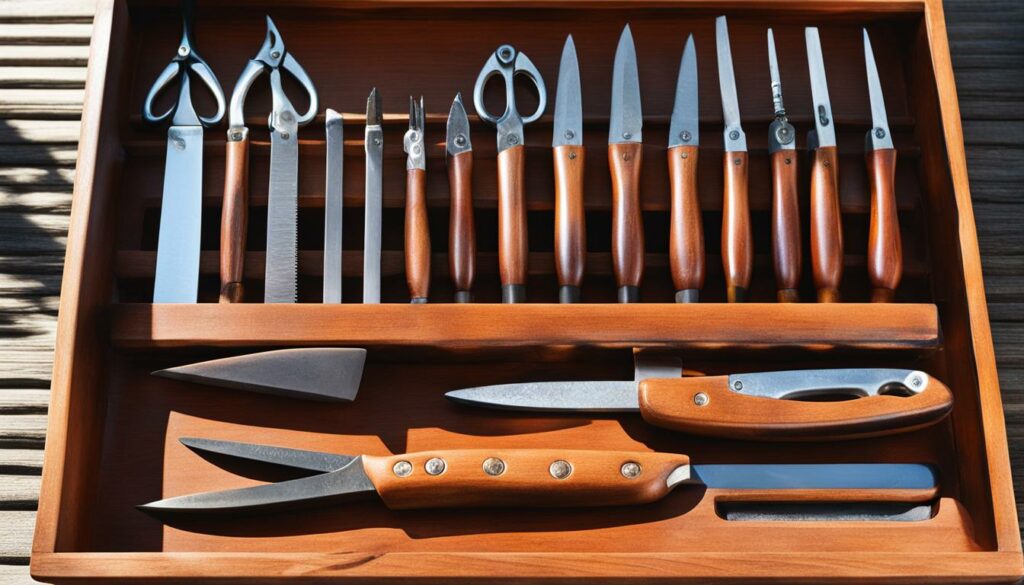
The Harmony Between Bonsai Tool Function and Form
The beauty of a bonsai tool lies in its dual capabilities. Every curve, angle, and sharp edge is crafted to serve a specific purpose, ensuring health and design come together flawlessly. While the form of these tools is designed with functional efficiency in mind, their polished and deliberate appearance contributes to the aesthetic appeal, not only of the toolkit but of the bonsai itself. It’s a reflection of how form marries function, highlighting an equilibrium essential for bonsai mastery.
How Quality Tools Elevate Bonsai to an Art Form
Quality tools do more than cut and shape; they are a vital component in transforming a simple tree into a bonsai masterpiece. High-caliber tools—made from the finest materials and crafted with precision—allow you, the bonsai artist, to work with confidence and finesse. The right tools can intricately carve textures and contours that define your bonsai’s character, demonstrating that bonsai is not just a hobby, but a discipline bursting with artistic value.
Finding the Best Deals: Online Resources and Buying Guides
As you delve into the art of bonsai, finding a quality Bonsai tool kit is imperative. Yet, this does not imply overstretching your budget. With the right online resources and buying guides, securing the best deals for premium tools becomes a savvy exploration rather than a challenge.
Begin your search on forums and websites dedicated to bonsai enthusiasts. These platforms often have sections where deals and discounts are shared by the community. Keep an eye out for seasonal sales from reputable bonsai supply brands, as these can be a prime opportunity to purchase that coveted high-grade maintenance equipment at a reduced price.
- Check online marketplaces with customer reviews to gauge the quality and durability of the bonsai tools.
- Subscribe to newsletters from specialized bonsai tool suppliers to get alerts on promotions and new arrivals.
- Follow bonsai experts on social media for recommendations and insider tips on purchasing the best equipment.
Moreover, buying guides can be invaluable, providing detailed comparisons and insights into different tool sets’ functionality and craftsmanship. A well-researched guide not only directs you to cost-effective choices but also educates on the nuances between tools, aiding in your decision-making process.
| Features to Consider | Benefit | Recommended Use |
|---|---|---|
| Material Quality | Durability and longevity | Regular maintenance and advanced shaping |
| Ergonomic Design | Comfort during extended use | Precise cuts and intricate care routines |
| Warranty and Brand Reputation | Assurance of tool replacement or repair | Long-term investment in a Bonsai tool kit |
| Price Comparison | Financial savings | Finding the most cost-effective deals |
Remember, investing in the right tools is investing in the health and beauty of your bonsai. By leveraging online resources and pragmatic buying guides, you ensure that every purchase contributes to the art and enjoyment of bonsai cultivation.
Conclusion
Through the course of this guide, we have traversed the essential terrain of equipping yourself with the proper Bonsai tools and maintaining a Bonsai tool kit that reflects the commitment to the artistry and health of your bonsai trees. Not only have we underscored the functional importance of having the right pruning tools on hand, but we’ve also illuminated the significance of tool care—both crucial elements that contribute to the thriving life of your miniature landscapes.
From the basic necessities to the advanced instruments used for detailed shaping, you have learned that each tool serves a unique purpose tailored to encourage precise growth and form. Implementing these tools with skill and care sets the foundation for not just keeping a bonsai alive, but for sculpting a living piece of art. This guide has aimed to arm you with knowledge—a knowledge that, when coupled with practice, matures into expertise.
As you continue to hone your craft, remember that the potency of your artistry lies not merely in owning a collection of tools, but in mastering their use to reveal the innate beauty of bonsai. Let every cut made by your shears, every curve navigated by your wire, and every granule of soil sifted through your fingers be a testament to the reverence you hold for bonsai culture. The path now lies before you—nurture your bonsai with precision, patience, and the right equipment in your hands, and the resulting splendor will be unequivocally yours to cherish.
FAQ
What tools are included in a basic bonsai tool kit?
A basic bonsai tool kit typically includes a selection of pruning tools such as scissors, branch cutters, and knob cutters. It may also contain wire cutters, pliers for wiring, and tweezers, along with other maintenance equipment needed for the detailed work involved in bonsai care.
Why is it important to select the right container for a bonsai tree?
The right container is essential for a bonsai tree as it affects both the health and growth of the tree, as well as the overall aesthetics of the bonsai presentation. The size, shape, and material of the container all play a critical role in ensuring that the bonsai’s roots have adequate space and that the tree is displayed to its best advantage.
How do advanced pruning tools enhance the shaping of a bonsai?
Advanced pruning tools are designed for precision work in the art of bonsai. These tools, such as concave cutters and spherical knob cutters, help to create a more natural and aesthetically pleasing appearance by enabling the artist to make clean, precise cuts that minimize scarring and promote healthy growth patterns.
What specialty bonsai tools might I need beyond the basics?
In addition to basic pruning tools, specialty bonsai tools like detailing knives, carving tools, branch benders, and jacks may be necessary for more advanced shaping and styling techniques. These allow for intricate design work, accurate placement, and bending of branches to achieve specific forms and styles.
Why is consistent hydration important in bonsai care, and what equipment is necessary?
Consistent hydration is crucial for maintaining the health of a bonsai tree as it ensures the tree receives the necessary amount of water to thrive. Tools like watering cans with fine nozzles or automatic watering systems help to provide an even and gentle distribution of water without disturbing the soil or damaging the tree.
How can I select bonsai tools that will last?
To select bonsai tools that will endure, look for high-quality, durable materials like carbon steel or stainless steel. Tools from reputable brands known for their craftsmanship are often a good investment. Additionally, check for ergonomic designs and solid construction, which are indicators of tools that are built to last.
What are the key steps in caring for bonsai tools?
Key steps in bonsai tool care include cleaning the tools thoroughly after each use to remove sap and debris, drying them to prevent rust, and applying a light layer of oil to protect the metal. Proper storage in a dry, organized space also plays a crucial role in maintaining the condition of the tools.
How do I use pliers and wire cutters when wiring a bonsai tree?
Pliers are used to carefully bend and twist the wire when shaping branches, giving you control over the precise direction of growth. Wire cutters are used to trim excess wire and to remove wires once the branch has set into the desired position, ensuring that the tree does not become constricted as it grows.
What should I avoid when pruning my bonsai to prevent over-pruning?
To avoid over-pruning, never remove more than one-third of the foliage at a time and focus on pruning during the appropriate season for your specific type of bonsai. It’s also important to have a clear design in mind before making cuts and to understand the growth patterns of your bonsai tree.
What makes a quality bonsai tool different from a regular gardening tool?
Quality bonsai tools are specifically designed for the delicate and precise nature of bonsai maintenance. They are typically smaller, more refined, and have sharper edges for cleaner cuts. High-grade materials and specific shapes allow for detailed work that regular gardening tools are not capable of achieving.
Where can I find reliable online resources and buying guides for purchasing bonsai tools?
Reliable online resources for purchasing bonsai tools include specialized gardening websites, online marketplaces with customer reviews, and the websites of professional bonsai artists or associations. Buying guides often feature on these platforms, providing insights into tool selection, use, and care.
